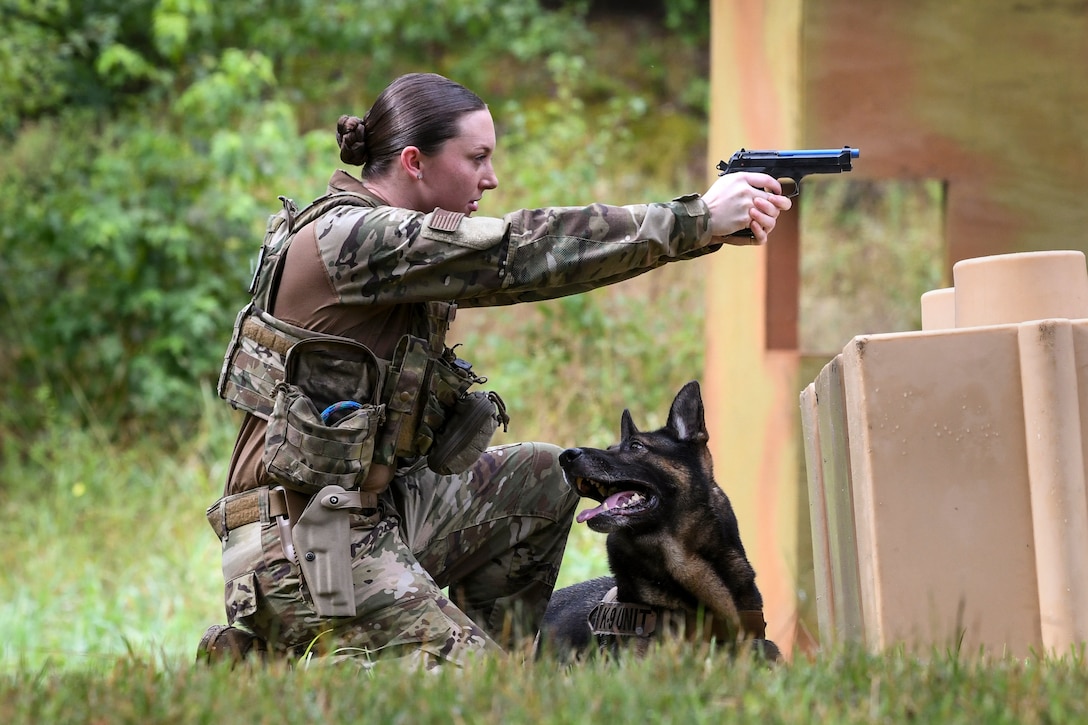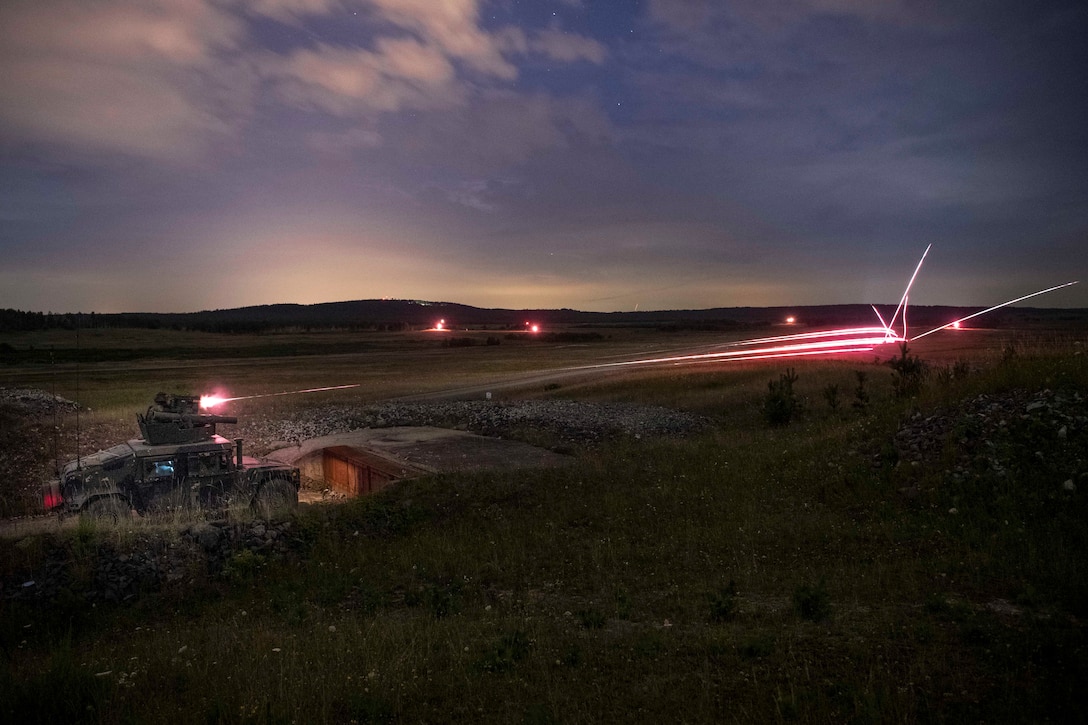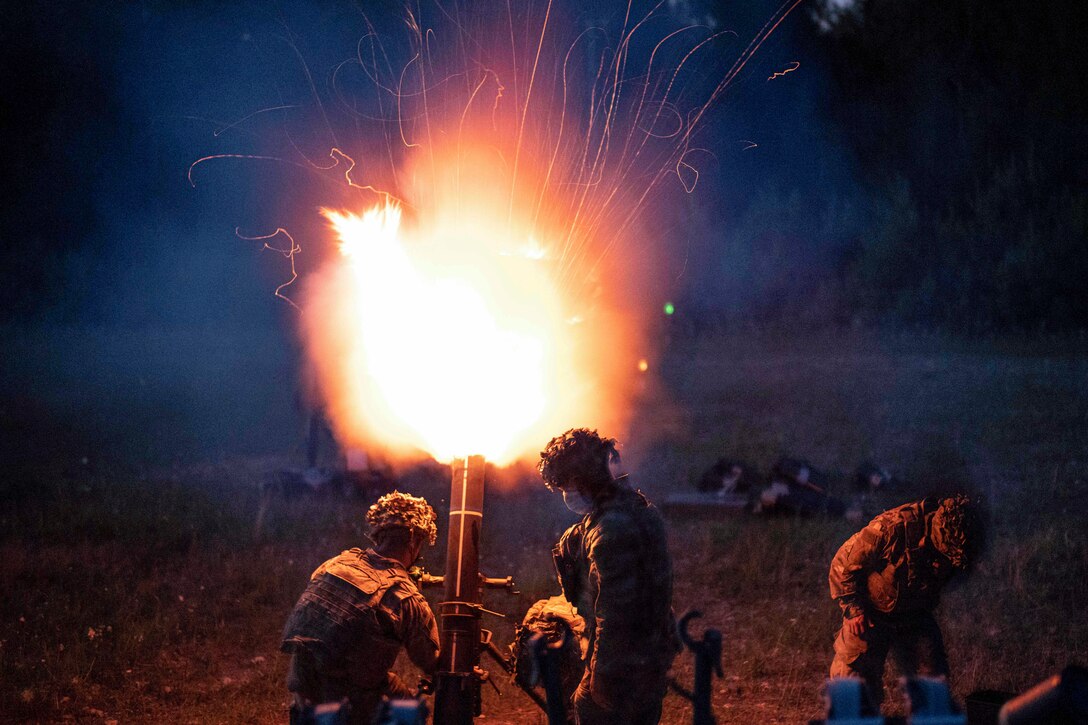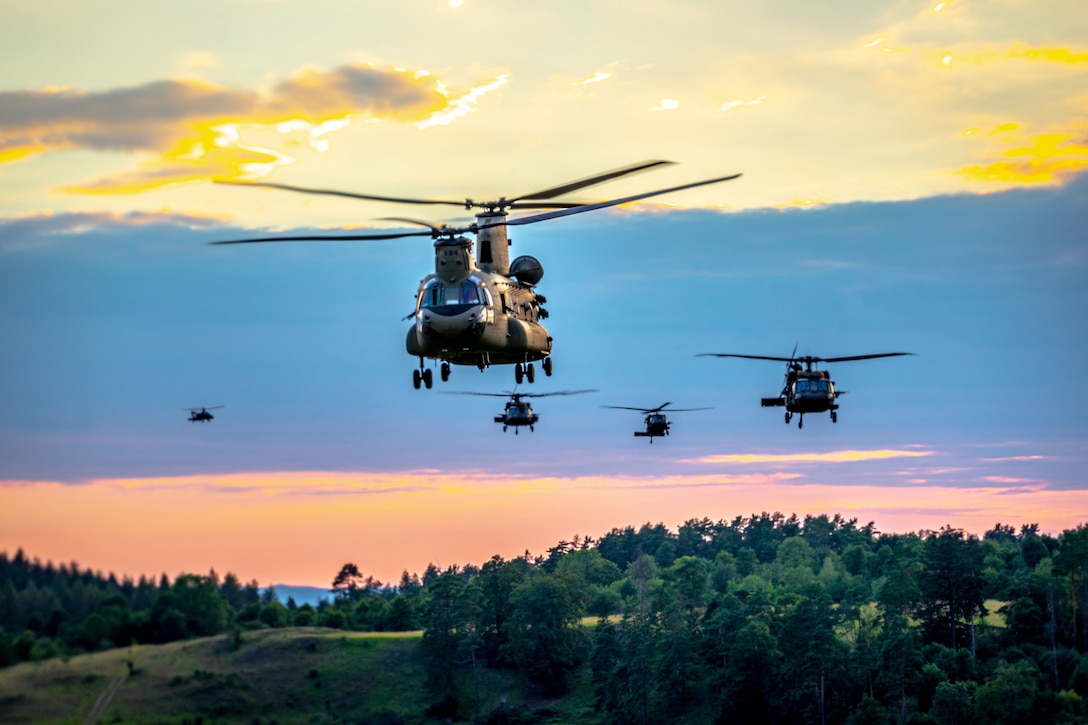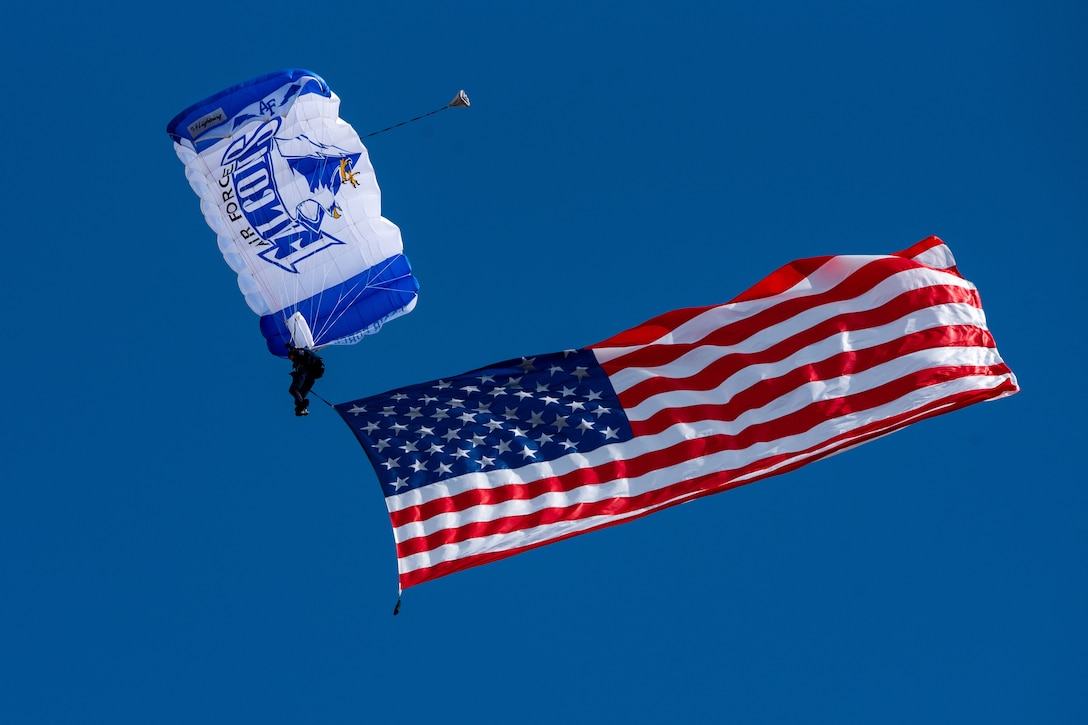Sailors fold a U.S. flag during a burial at sea aboard the USS Makin Island in the Pacific Ocean, July 26, 2020.
Providing up-to-date information, news and original content on American Military issues.
Monday, July 27, 2020
Top Dog Duo
Air Force Staff Sgt. Samantha Frydenlund aims at a target during a “Top Dog” competition at Joint Base Andrews, Md., July 24, 2020. The shooting portion of the event tested the ability of military working dogs to stay focused and respond well to erratic noises. Frydenlund, 316th Security Support Squadron Military Working Dog section handler, and her partner, Rocky, won the “Top Dog” title, scoring the most points overall.
Combat Medical Innovations Carry Over to COVID-19 Care
The long-standing wars in Iraq and Afghanistan taught the U.S. Military Health System to collaborate and innovate research and treatment among the three military services, and, for example, created the combat joint trauma system, a panel of physicians.
When the COVID-19 pandemic struck the United States this year, that joint trauma system took form almost immediately to gather data on COVID-positive patients in the MHS, Air Force Col. (Dr.) Todd Rasmussen, professor of surgery and associate dean of research, Uniformed Services University of the Health Sciences in Bethesda, Maryland, said today during a media roundtable discussion.

Joining Rasmussen on the call were Dr. Paul Cordts, chief medical officer for the Defense Health Agency in Falls Church, Virginia.; Dr. Simon Pincus, director of DHA's connected health branch; and Army Maj. (Dr.) Steven Hong, assistant professor of surgery at the USUHS and chief of head and neck surgical oncology and reconstructive surgery at Walter Reed National Military Medical Center, also in Bethesda.
Rasmussen called the joint trauma center a global system that uses data to monitor care of COVID-19 patients for the center's established registry to look at and gather data on how best to diagnose and care for patients.
"It's almost a worldwide [venue] where we go on rounds, but it's virtual," he said. "It's very much like what was done during combat casualty care during the wars, but now it's more focused on how best to diagnose and manage patients with COVID."
Using the joint trauma center system in the military and civilian medical sectors, doctors can evaluate their therapies in real time and adjust clinical practice guidelines, if necessary, toward therapies that appear to be most effective, he noted.
Another innovation MHS pivoted on in the parallels between combat and COVID-19 care is a provider resilience suite of self-care for health care workers. It's an app that also created useful tips to self-identify signs of burnout and how to deal with it, Pincus pointed out.
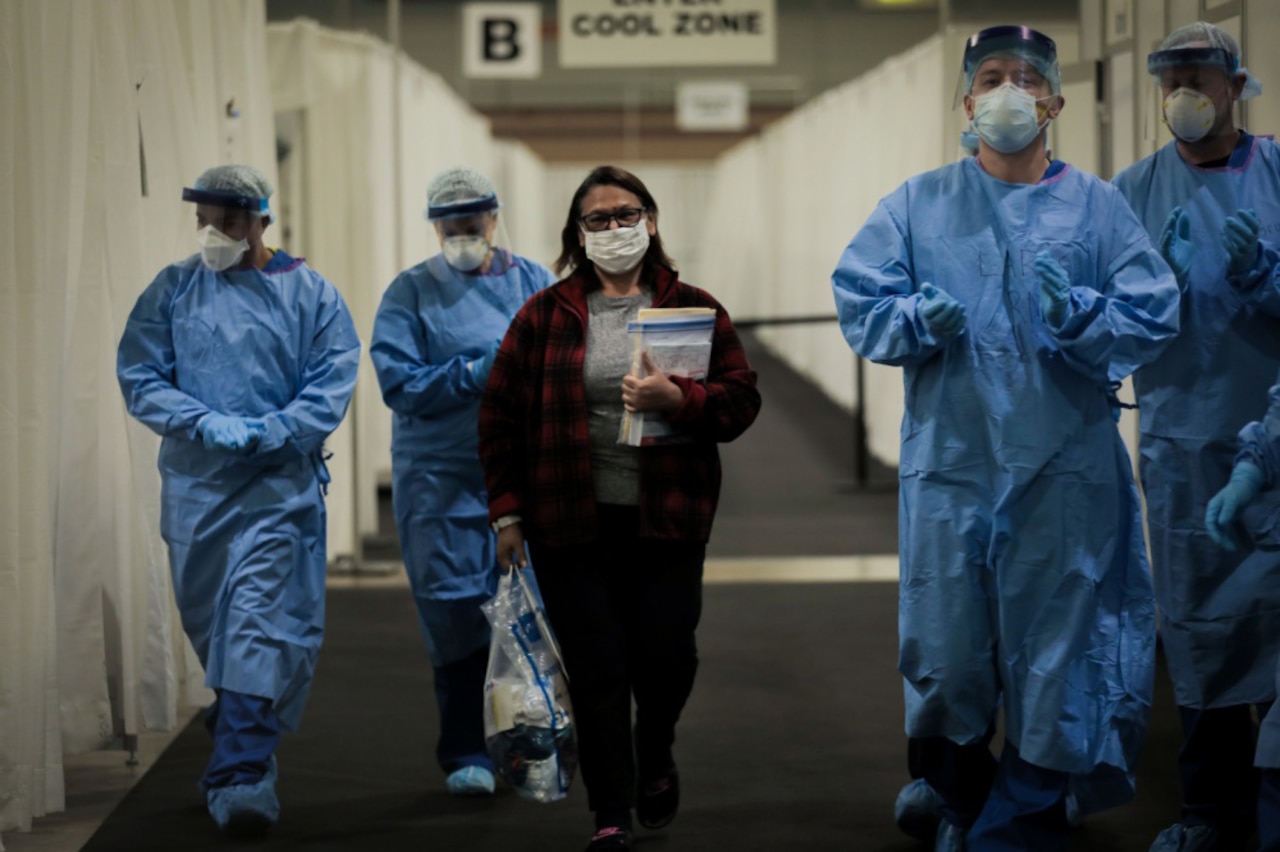
Virtual health is another concept that was used in downrange settings, and it is now being used for COVID-19, Rasmussen said. Virtual health is revolutionary for COVID-19, the panel said.
Also, the electronic medical record comes into play with COVID-19. Patients can fill out a questionnaire from home, using the patient portal, and pass it along to their doctor, where a clinical team can review the information and identify patients who are appropriate for COVID-19 testing or those who need further care, Rasmussen said.
"We really want to empower providers and patients digitally to improve the quality of care and health outcomes," Cordts said. COVID-19 has provided the opportunity in the midst of crisis coverage, and the technologies being used for COVID-19 have potential application for other infectious diseases, too, he added.
Gunnery Glow
An Army paratrooper fires at targets using an M240B machine gun during a night marksmanship gunnery event in Grafenwoehr, Germany, July 20, 2020.
Lighting the Night
Army paratroopers fire a 120 mm mortar illumination round during a field training exercise in Grafenwoehr, Germany, July 23, 2020.
Multihue View
Army helicopters participate in an aerial gunnery event at Grafenwoehr Training Area, Germany, July 20, 2020.
Wings of Blue
A member of the U.S. Air Force Academy "Wings of Blue" parachute team descends from the sky during the "Wings over Warren" air show at F.E. Warren Air Force Base, Wyo., July 22, 2020.
DOD, HHS Award $7.6 Million Contract to Hologic, Inc. to Expand Domestic Production of Custom Sample Collection & Processing Consumables for COVID-19 Tests
As part of an ongoing collaboration between the Department of Defense (DOD) and the Department of Health & Human Services (HHS), an undefinitized contract action with a ceiling of $7.6 million has been awarded to Hologic, Inc. on July 25 to expand domestic production of custom sample collection and processing consumables for COVID-19 testing.
This investment will enable Hologic, Inc. to expand domestic production of collection and processing consumables to support increased production and availability of COVID-19 tests for the United States. These Tube, Cap, and Multi-tube Unit (MTU) consumables are critical for performing molecular diagnostic tests on the Panther and Panther Fusion systems. Hologic, Inc. is currently producing these consumables in Wisconsin and distributing to customers out of their California and Tennessee distribution centers. Under the agreed upon project schedule, Hologic, Inc. expects to deliver the increased volume of consumables to market by January 2021.
The unprecedented demand for molecular diagnostic testing driven by the COVID-19 pandemic has exceeded Hologic, Inc.’s current production capacity for sample collection and processing consumables. Hologic, Inc. is positioned to support the demand for COVID-19 testing in the United States due to the installed base of more than 1,100 fully-automated, high throughput Panther and Panther Fusion systems. These Panther systems are each capable of performing up to 1,000 tests in a 24-hour period.
This effort has been led by the DOD’s Joint Acquisition Task Force (JATF) in coordination with the Department of the Air Force’s Acquisition COVID-19 Task Force (DAF ACT) and funded through the Paycheck Protection Program and Health Care Enhancement Act (PPPHCEA) to enable and support domestic industrial base expansion for critical medical resources.
Ohio National Guard Helps Build Urban Farm to Support Food Banks
In March, with food insecurity issues becoming widespread across the state during the COVID-19 pandemic, Ohio National Guard soldiers and airmen were called upon to provide extra support at regional food bank warehouses and local pantries to help with food packaging and drive-thru operations.
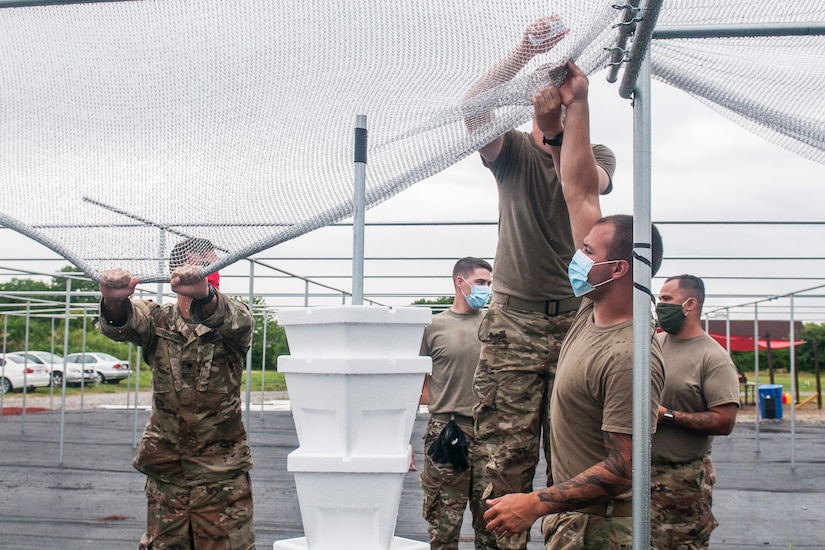
In addition to packaging and drive-thru support, about 15 guardsmen helping at the Mid-Ohio Foodbank had a unique task ahead of them — building an urban farm.
Known as the Mid-Ohio Farm on the Hilltop, the farm is located in the Hilltop neighborhood just west of downtown Columbu. It will serve as an outlet for the food bank to have quick access to fresh, local produce while also serving as a place to provide hands-on education for the community.
Army Sgt. Jacob Eader, a fire control specialist assigned to the 1st Battalion, 134th Field Artillery Regiment, was more than happy to use his civilian-occupation skills to help with the project. "Me being a carpenter is ... knowing how to do things and knowing how to teach people how to do things here at the farm," he said.
Bo McMahon, a fifth-generation farmer whose family's agricultural roots are in Nebraska and Florida, found his way to Ohio to become the farm manager for the Mid-Ohio Foodbank. He expressed his gratitude for the guard and applauded their efficiency. "Soldiers like Sergeant Eader that have a background and specific skills, that is so valuable having them out here," McMahon said.
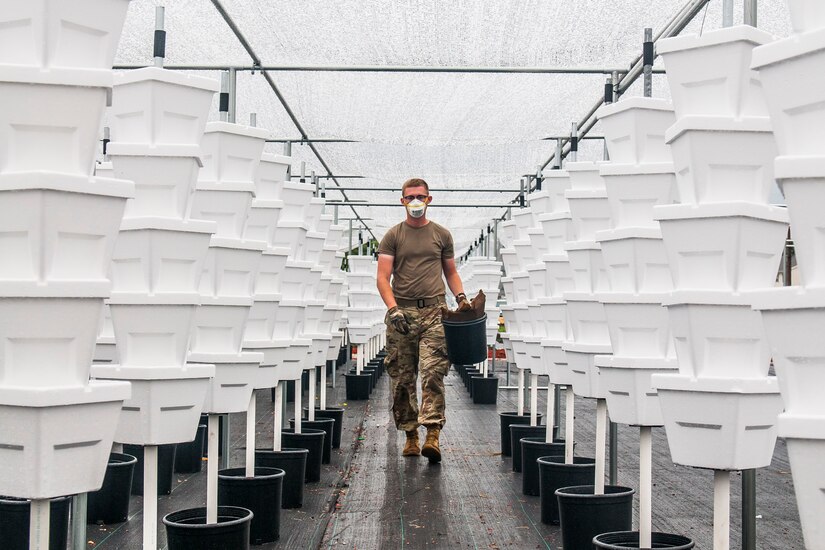
The guardsmen's drive and teamwork motivated him every day, McMahon said, and fueled his passion for his project even more.
"Everybody who's been out here has been super excited about what they're doing," McMahon continued. “I get energized seeing them out here and their willingness to help with everything."
At the project's outset, very few of the guardsmen had formal training in constructing an urban farm, but they brought a strong work ethic and a willingness to absorb new skills. Eader said this project has brought them together in ways that will benefit how they operate in their military environment.
"Some of these guys out here, they don't know what they’re doing, and that’s OK," Eader said. "They're willing to learn, and I'm willing to teach them. That bond together brings us closer and makes our work even better."
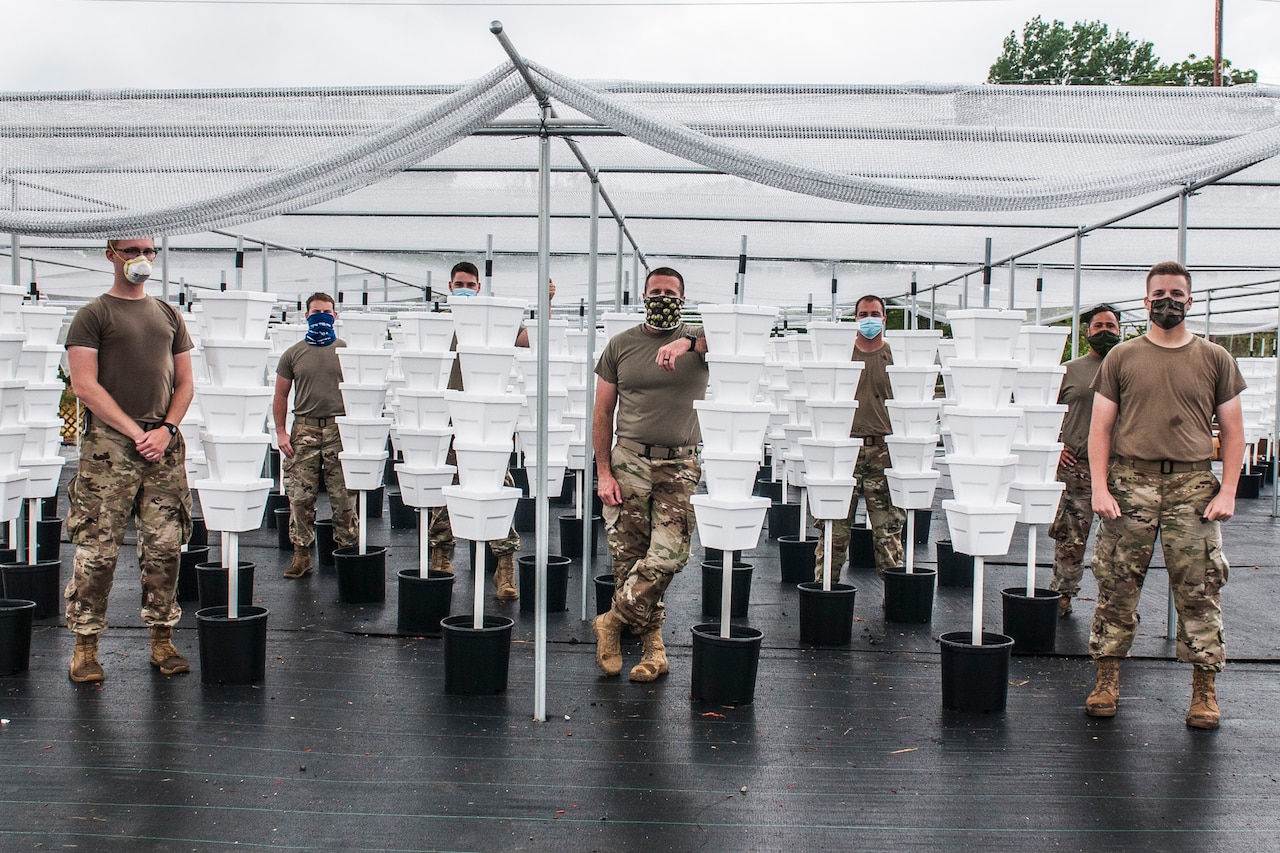
The urban farm will be not only be a place to grow produce, but also a place to grow communities. McMahon said the site eventually will have a market, interactive cameras to stream into classrooms, and a kitchen where people can prepare dishes using the produce grown on-site. McMahon said the possibilities are endless. He compares the farm to an ecosystem.
"Each thing depends on the other to thrive," McMahon explained. "It's not just one thing, it's everything. It takes everything together to become successful."
McMahon's philosophy on unity and Eader's passion for teaching others have established the foundation of what this ongoing, community project will one day represent — a place where people can come together to learn and grow.
"Giving back to the community is what I joined the National Guard for," Eader said. "It makes me feel this sense of camaraderie."
(Army 1st Lt. Caroline Pirchner is assigned to the Ohio National Guard.)
Partnership Establishes Quarantine Facilities in Kuwait
U.S. soldiers from the 3rd Medical Command and Task Force Spartan toured a unique quarantine facility operated by the Kuwait Defense Ministry of Defense on July 3.
A result of the U.S.-Kuwaiti partnership, the facility is located at a renovated family-friendly amusement center in downtown Kuwait City.
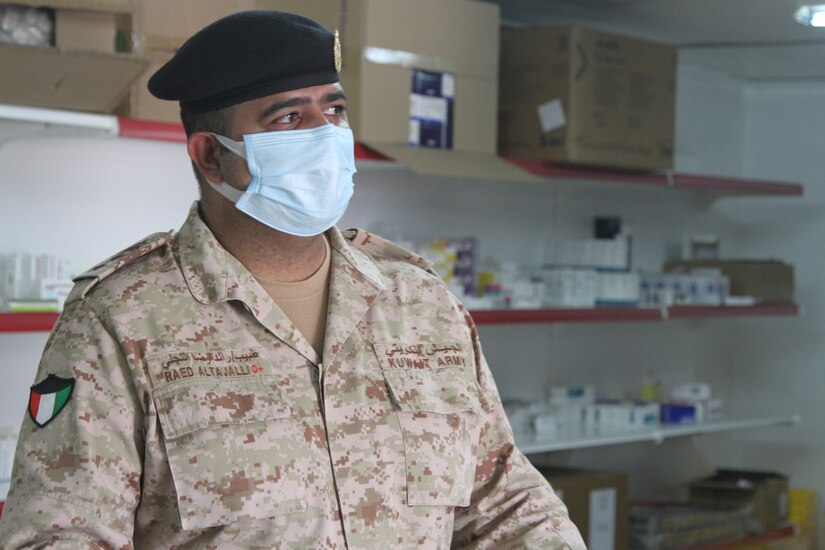
Army Col. Darrin Dailey, a military liaison from the 3rd Medical Command, who has been working closely with Col. Raed Altajalli of the Kuwaiti army, the commander of the COVID-19 facility, said the 3rd Medical Command's role in the partnership has focused solely on advising the host nation.
''[We have] assisted these camps purely from an advisory role,'' Dailey said. ''Colonel Altajalli used the blueprint of [Camp] Arifjan's quarantine and isolation facility for his own.''
Dailey said the 3rd Medical Command provided a liaison to discuss any issues the Kuwaitis may have, along with a logistics team to advise and assist in improving the facilities' supply system.
Altajalli said the site started accepting patients in April and can handle between 1,000 to 1,200 patients, but it comes with its challenges — including maintaining cold water without damaging equipment such as refrigerators.
''Hot water was the biggest challenge with the camp because of the tent, coolant inside and the electricity. And all of this stuff, it is affected by the heat. … Heat has broken everything, so this is our main challenge,'' Altajalli said.
Within the facility, most tents can hold up to four patients and include air conditioning, wall lockers and a communal refrigerator.
In addition to providing medical and logistics support, engineers from the New York Army National Guard's 42nd Infantry Division advised the more technical parts of setting up quarantine facilities.
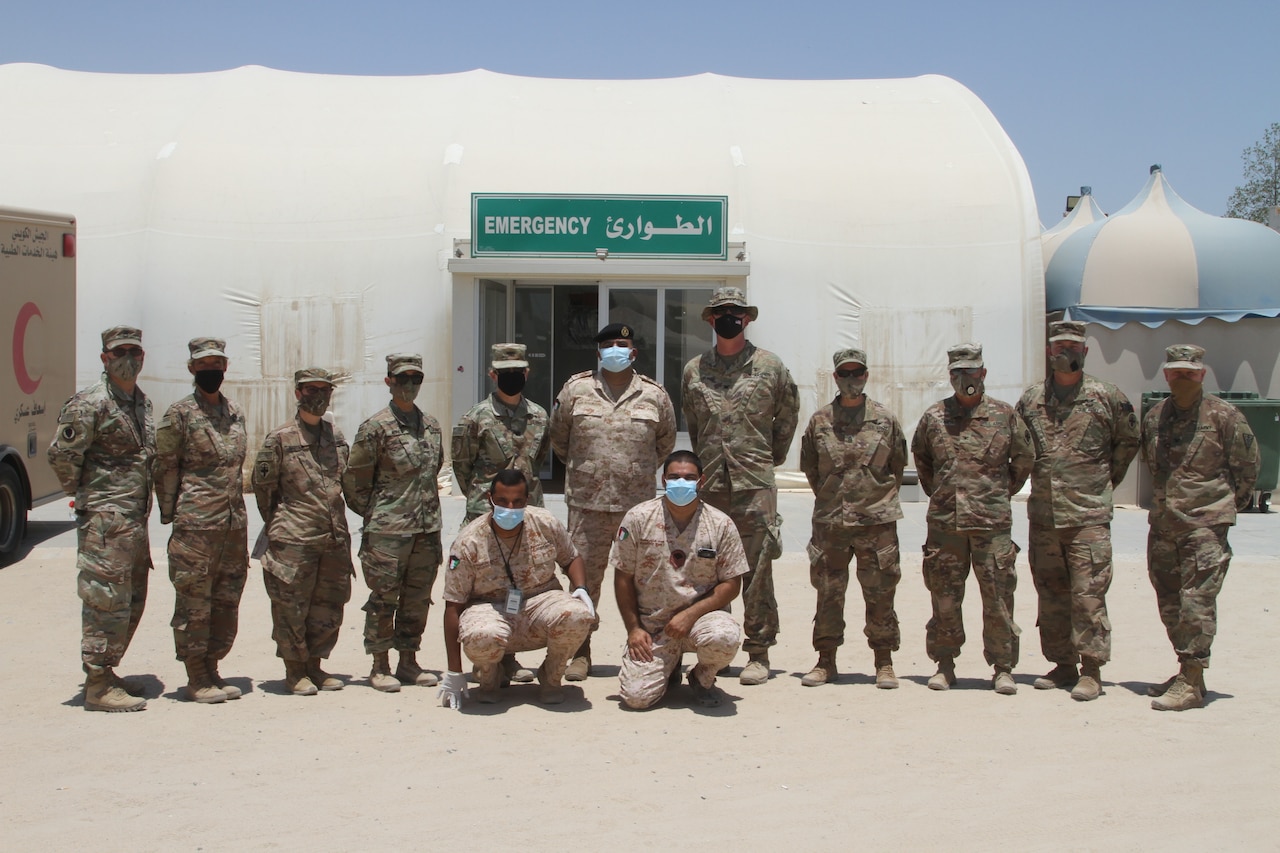
Army Lt. Col. Michael Rodriguez, Task Force Spartan shield division engineer, spoke about the work his team did in advising the Kuwaiti Defense Ministry. ''We started meeting with them, and they said they needed confirmation that the setup was good,'' Rodriguez said. ''They were looking at building out capacity. They looked at schools or warehouses that they could reutilize, so that was our input.''
With the help of Rodriguez and his team, the Defense Ministry now has templates of how to set up similar facilities for future events or emergencies.
''The Kuwaitis will have a plan that will be vetted in place that they can utilize and feel confident that they can execute an emergency management plan,'' Rodriguez said.
Both Dailey and Altajalli said they are happy with the transparency and partnership between nations. ''It’\'s been a great diplomatic relationship,'' Dailey said.
''We are doing our best, working with my friend Colonel Dailey, exchanging the information, and it's very transparent,'' Altajalli said. ''At the end of the day, we are on the same page and trying to keep our officers and soldiers as safe as we can from the coronavirus.''
(Army Sgt. Andrew Valenza is assigned to Task Force Spartan.)
DOD Supports Women, Peace and Security Act, Official Says
In her prepared remarks, Stephanie Hammond, acting deputy assistant secretary of defense for stability and humanitarian affairs, gave an overview of how the Defense Department is implementing the Women, Peace, and Security Act and Strategy at a July 23 hearing of the House Oversight and Reform Committee's national security subcommittee. The hearing focused on the implementation of the U.S. Strategy on Women, Peace and Security.
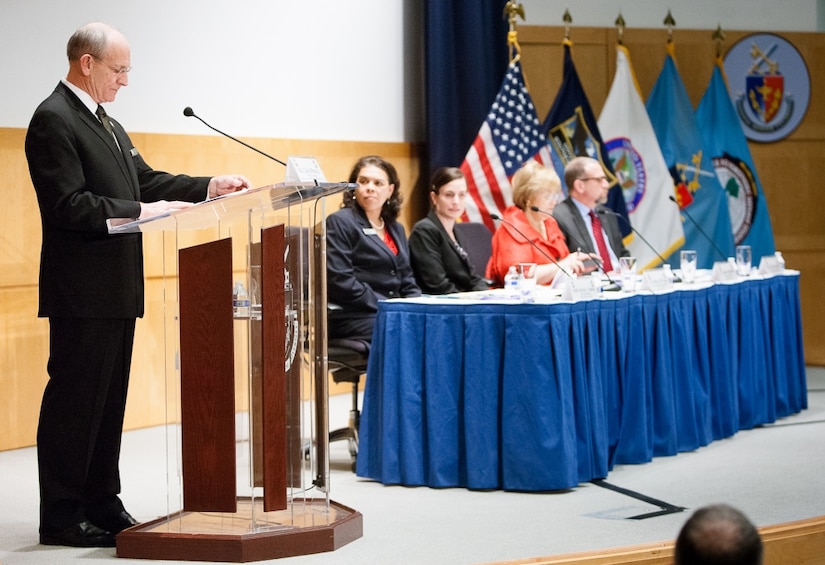
''As our adversaries and competitors continue to seek a strategic advantage, the United States and our partners must be better prepared to meet security challenges by recognizing the diverse roles women play in conflicts, and by incorporating their perspectives throughout our plans and operations,'' Hammond said. ''Advancing the U.S. Strategy on Women, Peace and Security provides a unique engagement opportunity to strengthen relationships with U.S. allies and partners through collective efforts to reinforce women's empowerment, meaningful participation in decision-making, protection from violence and access to resources.''
Hammond told the subcommittee that last month, in accordance with the Women, Peace and Security Act of 2017 and the U.S. Strategy on Women, Peace and Security, the Defense Department and its interagency partners launched its Women, Peace and Security Strategic Framework and Implementation Plan.
''This document is the first departmentwide implementation plan that outlines how the department will support the intent of the U.S. Strategy on Women, Peace and Security through attention to the composition of our personnel and the development of our policies, plans, doctrine, training, education, operations and exercises,'' she said.
This approach will support the National Defense Strategy, Hammond said, and increase the Defense Department's operational effectiveness.
The plan details three overarching defense objectives, she noted, to orient DOD's implementation of the U.S. Strategy on Women, Peace and Security. The three objectives are:
- Defense Objective No. 1: DOD exemplifies a diverse organization that allows for women’s meaningful participation across the development, management and employment of the joint force.
- Defense Objective No. 2: Women in partner nations meaningfully participate and serve at all ranks and in all occupations in the defense and security sectors.
- Defense Objective No. 3: Partner-nation defense and security sectors ensure women and girls are safe and secure, and that their human rights are protected, especially during conflict and crisis.
''DOD's implementation of the Women, Peace and Security agenda highlights and builds upon best practices that strengthen our armed forces and further our national security objectives,'' Hammond said. ''Since the enactment of the WPS Act of 2017 and the approval of the U.S. Strategy on WPS, the department has significantly increased its WPS activities, with generous support of funding from Congress.''
Hammond noted that the department has implemented WPS by building an active network of subject matter experts at combatant commands, as well as the Joint Staff and the Office of the Secretary of Defense. These personnel advise commanders and staffs on how to integrate gender perspectives into operations, and engage with partner nations on women, peace, and security through activities such as conferences, training events, standard operating procedure development, and emphasis on WPS principles in military operations and multilateral exercises such as Flintlock, Khaan Quest, Gema Bhakti, and Pacific Sentry.
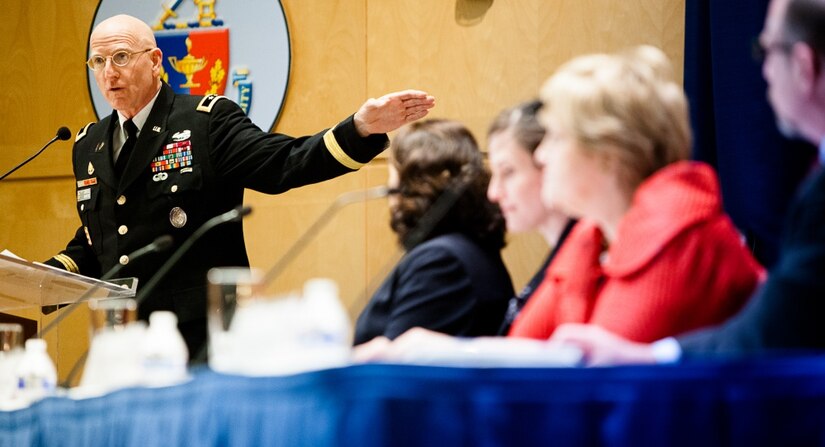
The department has engaged more than 50 partner nations to demonstrate the value of women's meaningful participation, empowerment and safety to national security, and to share best practices on the recruitment, employment, development, retention, and promotion of women in military forces.
For example, Hammond told the House panel, U.S. Africa Command has worked with the Nigerien armed forces to adapt their recruitment methods to increase the number of women in their ranks and to promote women into leadership positions, U.S. Indo-Pacific Command has engaged with a local organization in Mongolia to work with women in rural areas to build their resilience capacity and leadership skills in disaster response and relief efforts, she said.
''With the launch of the department's Women, Peace and Security Strategic Framework and Implementation Plan, DOD will further institutionalize and expand on the critical WPS work across components, and continue to coordinate closely with and support our interagency partners on this initiative to make the United States safer and more secure,'' Hammond said.

